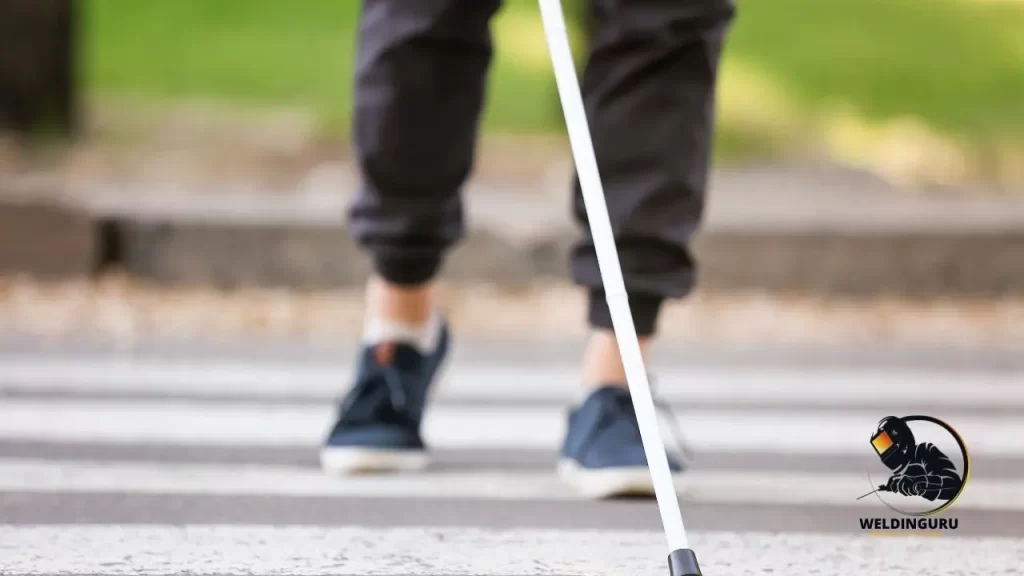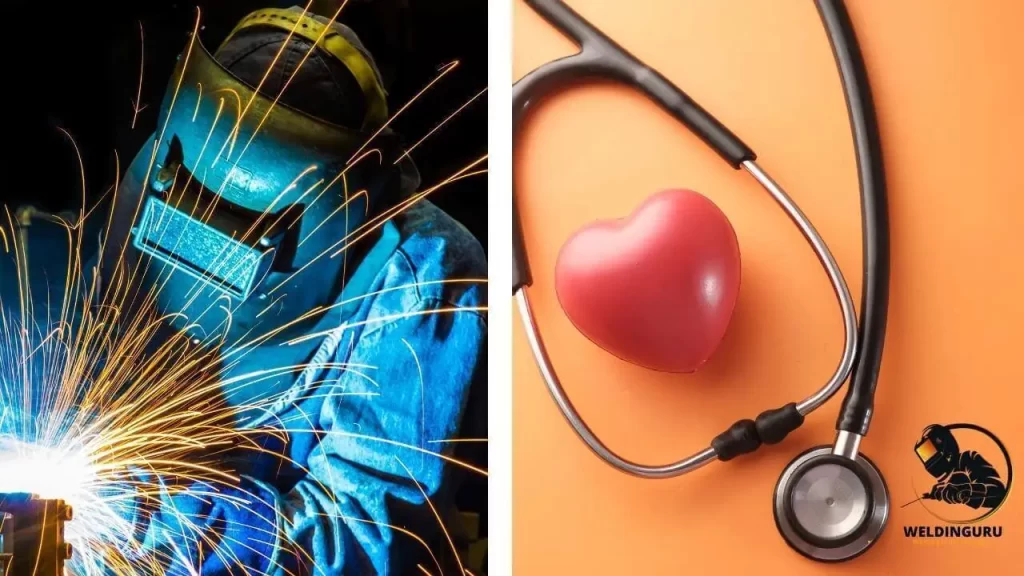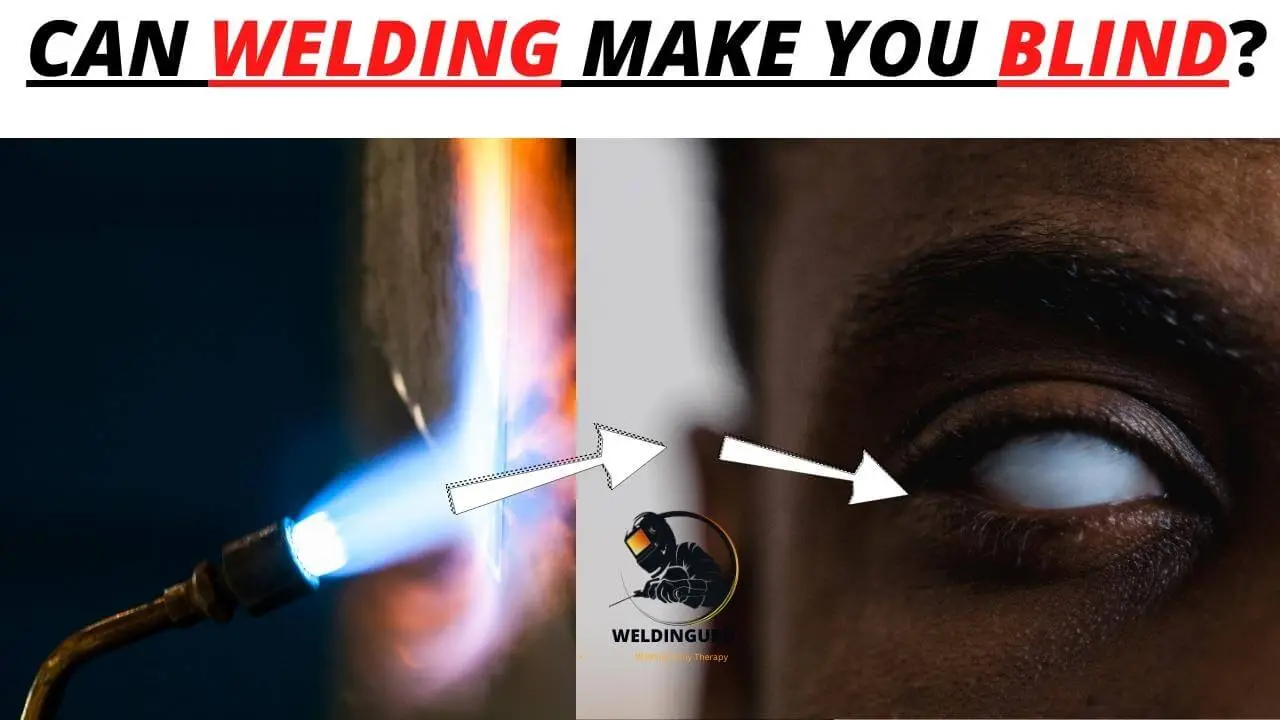Welding can save lives and build communities. It can strengthen bridges, repair roads, and make buildings and homes safer.
Welders are an irreplaceable part of the workforce, often providing functions that other trades cannot perform. These are just some of the many valuable things that welding does.
Can welding make you blind? The main thing we need to look into is the safety gear that welders use while they are working. Most of the safety gear, like welding helmets or goggles used by welders, are related to ultraviolet light.
How can you avoid this from happening? Here we are going to talk about whether or not welding can make you blind. Continue reading to find out.
Can Welding Make You Blind?
Welding, like many other professions that involve intense light exposure, can cause eye damage. Some cases of photokeratitis can lead to corneal abrasions or ulcers that can make you blind if not treated properly. Welding can make you blind after some time of eye damage if you don’t take the proper precautions and medical assistance.
The most common causes related to welding are arc eye and flash burn. Both of these can occur when you are not wearing your safety glasses or welding helmet. If you look directly at an arc or hot metal, it can cause damage to your eyesight.
So, you should always wear your welding helmet and protective eyewear. Welding can cause flash blindness from the bright light of the arc and sparks.
If a weld is done incorrectly and sparks are scattered, they can cause flash blindness as well. The best way to avoid this is I recommend that put on your protective gear before starting your welding project.
How Long does it Take to Go Blind from Welding?

If you’re worried about going blind from welding, you might be wondering how long it will take for you to lose your vision. The short answer is that it depends on a number of factors, including the type of welding you do and how often you do it.
If you work as an arc welder, your risk of going blind is much lower than if you work as a shielded metal arc welder (SMAW).
For example, one study found that welders who worked with SMAW were almost three times more likely to suffer from maculopathy, a condition that causes vision loss, than welders who worked with arc welding. The good news is that there are plenty of ways to protect yourself from eye damage while at work.
Wear protective eyewear when working near any source of radiation, and make sure that the goggles provide adequate protection against UV rays and infrared light.
In the end, I recommend that before starting your welding project, you should have to wear eye protection like welding helmets or goggles. If you wear and do your welding project with care and precautions, then there is no issue at all.
Why is Welding Bad for your Eyes?

Welding is a dangerous job. In addition to the risk of fire, burns, and electrocution, welders are also at risk of developing eye problems because of their exposure to high levels of ultraviolet radiation from the arc.
Welders are susceptible to a variety of eye problems, including cataracts, retinal damage, and corneal abrasions.
In addition to welding protection glasses, welders may also need special visors that cover the entire face and protect against UV rays, as well as sparks that can fly off the welding tool.
Even with these precautions in place, however, there is still a chance that welders will suffer from an injury or disease related to their eyesight. But it only happens if you do not follow the safety precautions & guidelines.
Also See: Explanation of All Types of Welding Joints
Things to Watch Out
Welding is a great way to make a living, but it can be tough on your eyes. If you’re in the welding industry, you need to make sure that you take good care of your vision so that you can continue working.
Here are some things to watch out for:
1. Burning or Tearing:
This happens when chemicals from the welding process enter your eyes and cause damage. It might be hard to tell whether or not this is happening because it can happen even if you’re wearing safety glasses.
But if you notice any of these symptoms while you’re welding, it’s best to stop working and give yourself time to recover before continuing on with the project.
2. Loss of Color Vision:
If your eyes have trouble distinguishing between different colors like red and green, then this could mean that they’ve been damaged by the heat of the welders’ light. Stop using them immediately until your eyes recover.
3. Blurred Vision:
Blurry vision can mean a lot of different things, but most commonly, it means that your cornea has become dehydrated due to excessive exposure to UV radiation from welding machines or other sources like sunlight or fluorescent lamps without proper protection such as goggles or glasses with UV-blocking lenses.
4. Eye Redness:
Eye redness is one of the first signs of eye damage from welding. It’s caused by exposure to ultraviolet light from the arc or sparks of metal, which can burn the cornea and lead to cataracts later in life.
The damage can also cause a condition called photokeratitis, which is inflammation of the cornea that usually clears up on its own within a week but can cause permanent scarring if left untreated.
5. Watery Eyes:
Another common sign of eye damage is watery eyes. This can occur when you’re working with metals like aluminum and magnesium, which contain metal oxides that are known to cause problems with vision over time. If you notice watery eyes while welding, stop working immediately and consult an optometrist!
Eye Injuries from Welding
Welding is a dangerous profession, and many welders are affected by eye injuries. As the welder’s eyes are exposed to the heat, light, and sparks of welding equipment, they can be damaged in a number of ways.
Welders should wear proper protective eyewear to protect their eyes from injury. The most common types of eye injuries among welders are corneal abrasions, photokeratitis (sparks), ultraviolet radiation damage, and arc eye (welder’s flash).
What Causes Arc Eye?
Arc eye is a medical condition that results from corneal damage. It occurs when ultraviolet light, such as that emitted by welding torches, causes a chemical reaction with the tear film on your eyes.
This reaction creates a bright white spot in your vision, which is often accompanied by pain and sensitivity to light.
Arc eye isn’t usually permanent but can last for several hours or even days after exposure to UV light. If you experience arc eye symptoms and have been exposed to UV light recently, it’s important that you seek medical attention immediately.
This can occur when you are working with high-voltage equipment or standing too close to an arc flash.
The symptoms of arc eye include:
- A feeling of grit in your eyes
- Dry, gritty pain in your eyes
- Redness and swelling of the eyelids
- Severe pain in your eyes
Health Problems Associated with Welding

Welding is a job with many benefits and few drawbacks. It is an excellent source of income, and it allows you to work outdoors in a variety of settings.
However, there are some health problems associated with welding that you should be aware of before beginning this career path.
The most common health problems associated with welding are eye injuries and hearing loss. All welders should wear protective glasses at all times when working on projects because sparks can fly off the metal as it is heated up and cause damage to the eyes if not properly protected.
It’s also important to wear hearing protection because loud noises can cause permanent damage to your ears over time.
Other common issues include skin irritation from getting too close to the hot metal during welding or from chemicals used in the process; back pain from leaning over while working; cuts on hands from handling sharp tools like saws; headaches due to fumes given off by metals being heated up; and muscle strain caused by lifting heavy materials such as steel rods up into place during construction projects.
I am a welder and have been doing welding for the past few years. It doesn’t mean that this profession is unsafe, but you should have to follow all safety precautions.
So, again I suggest wearing safety gear whenever you want to perform your welding project because safety is better than any injury.
How to Prevent Eye Injuries from Welding?
Eye injuries are a common problem for welders. The most common symptoms of welding-related eye injuries are irritation, redness, and pain in the eyes. Some people experience a temporary loss of vision after an injury.
In order to prevent eye injuries from welding, you should have to follow the following safety precautions:
- You should wear safety glasses with side shields that fit tightly around your face.
- You should also wear goggles or helmets with side shields if you’re working with an extremely bright light source or molten metal.
- You should also wear protective clothing over any exposed areas of skin, such as gloves and long sleeves. This will help protect your eyes from sparks that become embedded in your skin through friction when you move around while working on projects that require heavy lifting or digging into concrete surfaces (which can cause cuts).
- If you notice any signs of discomfort after working with equipment that has been used for welding jobs, such as arc welder torches or plasma cutter torches, then it’s important to seek medical attention immediately so that doctors can diagnose any potential injuries that may have occurred during the process (such as burns).
- Don’t wear contact lenses while welding because they can get stuck in your eyes and lead to serious infections due to the high heat generated during the process.
Safety Steps to Take When Welding
Welding is a fun, versatile, and useful skill to have. But it’s also a dangerous activity that can result in serious injuries if you don’t take proper precautions.
When you’re welding, there are several steps you can take to ensure your safety. These include:
1. Proper Protection:
Wear protective gear. Make sure your welding helmet, gloves, and other protective clothing fit properly and are in good condition. If you’re working with metal or if the metal is hot enough to cause burns, wear long sleeves and pants too!
2. Ground Clamp:
Use a ground clamp when working with electrical equipment. This will help prevent shocks from occurring due to a short circuit caused by stray electricity running through the ground wire of your tool or appliance.
3. Keep Away Flaming Materials:
Keep flammable materials away from where you’re welding, so they don’t catch fire or explode (this includes things like gasoline or propane). Also, make sure all children are out of the area where you’re working—they could be seriously injured by flying sparks!
4. Use Earplugs:
Wear earplugs to protect your hearing from the sound of the welder and to prevent damage caused by prolonged exposure to noise levels above 85 decibels (dB).
The American National Standards Institute recommends wearing earplugs when exposed to 100 dB or more for any length of time, which would occur during one hour of continuous operation of a typical industrial power welder producing 120 dB at 1 meter.
5. Check Connections:
Check all connections before starting any type of welding process; make sure all connections are tight, clean, and free of corrosion.
Wrapping Up:
Can welding make you blind? I think the takeaway from this should be that welding without eye protection is not only unwise, but it can also make you blind. So it’s very important to wear an appropriate face shield or welding helmet when welding.
The investment in welding safety equipment does pay off through added safety and productivity, but it’s crucial to realize that not wearing proper protective equipment can create safety issues for you.
FAQs:
How do welders prevent blindness?
First, welders must wear special helmets, face shields, and eye protection to protect their eyes from flying sparks. Safe welding goggles and metallic glasses which protect both the eyes and the forehead are essential. When they use gas welding equipment, they must also be sure to have the ventilation system in their workplace working properly. Since welding can increase workers’ risk of developing cataracts.
How do you get rid of the welder’s eye?
Some ways to get rid of a welder’s eye include wearing protective eyewear, eating well, and getting plenty of sleep. The symptoms of the welder’s eye can be treated with home remedies, and medication increases blinking frequency and decrease tear production, helping to flush away inflammation from the eyeball.
What welding eye feels like?
Welding eye is a condition caused by excessive exposure to light and can be caused by the eyes being struck by a welding arc.
